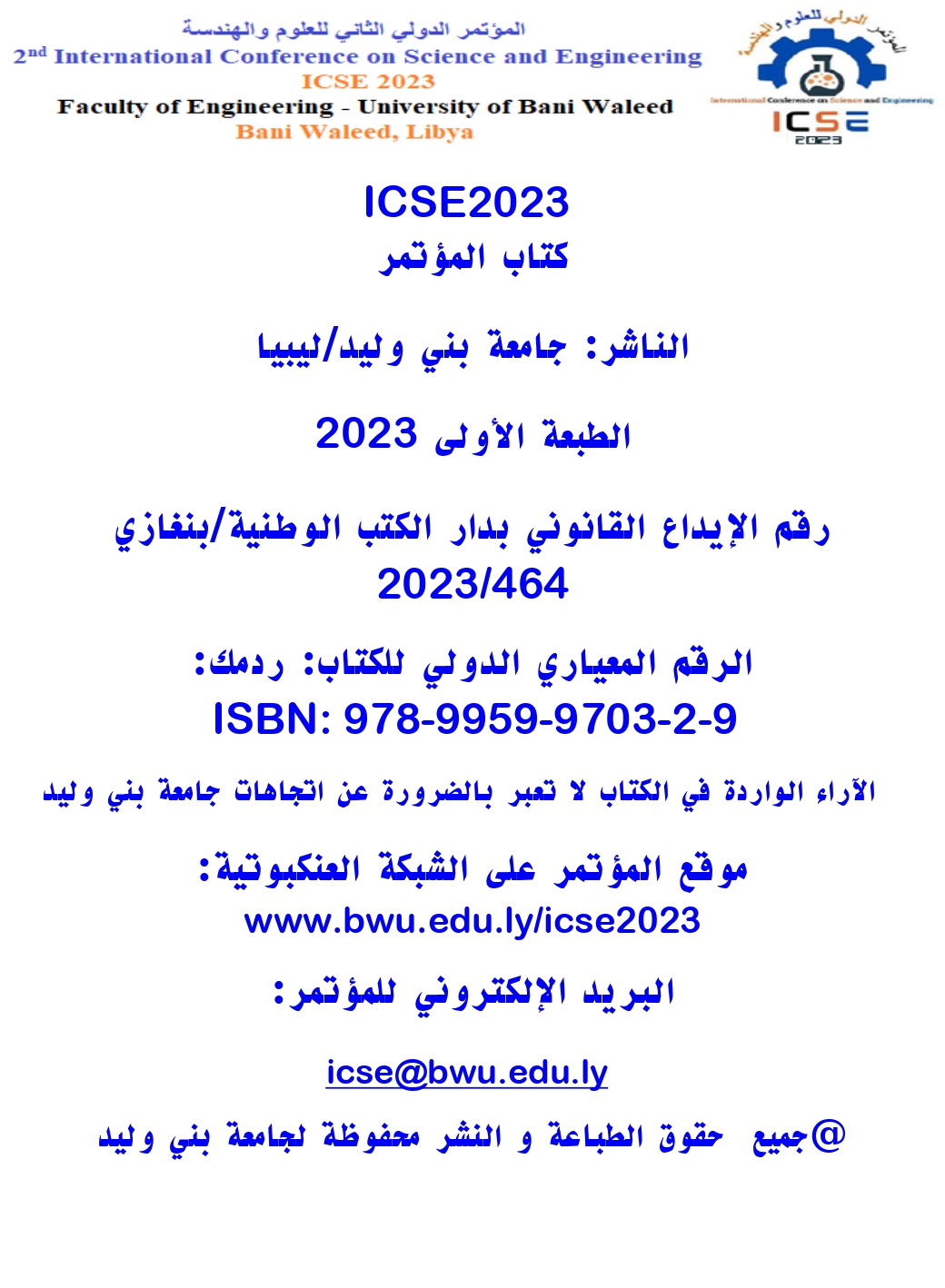Physico-mechanical and sulfate resistance evaluation of concrete made with ground granulated blast-furnace slag.
DOI:
https://doi.org/10.58916/jhas.v8i3.164Keywords:
Ettringite, , magnesium sulfate, mechanical strength, sodium sulfate, sulfate attackAbstract
Abstract: In recent years, with the aim of restricting the formation of ettringite and reducing the environmental impact associated with cement manufacturing, the incorporation of ground granulated blast-furnace slag (GGBS) as a partial replacement of cement has become a common tendency, due to its efficiency in enhancing the physico-mechanical properties of concrete. This research study reports the experimental results on the properties of concrete containing GGBS at different partial cement substitution levels (0, 50, and 75%). A total of three concrete mixes were manufactured using a water/cement ratio (w/c) of 0.55 and binder: sand: aggregate proportion of 1: 2: 3. Thereafter, a physico-mechanical evaluation including slump test, compactability degree test, unconfined compression strength (UCS) test, tensile splitting strength (TSS) test and sulfate attack, were performed to assess the concrete performance. The experimental results suggested that, although the use of GGBS as a partial cement replacement slightly affects the mechanical performance at the early curing age, its usage improves the consistency and yielded a higher residual mechanical performance after immersion in sulfate solution, particularly at higher substitution level (75%).
Downloads
References
Abdalla, T.A., Koteng, D.O., Shitote, S.M., and Matallah, M., (2022), Mechanical and durability properties of concrete incorporating silica fume and a high volume of sugarcane bagasse ash., Results in Engineering., 16, 100666. DOI: 10.1016/j.rineng.2022.100666.
Adeleke, B.O., Kinuthia, J.M., Oti, J., and Ebailila, M., (2023), Physico-mechanical evaluation of geopolymer concrete activated by sodium hydroxide and silica fume-synthesised sodium silicate solution., Materials., 16(6), 2400. DOI: 10.3390/ma16062400.
Nukah, P.D., Abbey, S.J., Booth, C.A., and Oti, J., (2022), Evaluation of the structural performance of low carbon concrete., Sustainability., 14(24), 16765. DOI: 10.3390/su142416765.
Samad, S., Shah, A., and Limbachiya, M.C., (2017), Strength development characteristics of concrete produced with blended cement using ground granulated blast furnace slag (GGBS) under various curing conditions., Sadhana - Academy Proceedings in Engineering Sciences., 42, 1203-121342. DOI: 10.1007/s12046-017-0667-z.
Oti, J.E., Kinuthia, J.M., and Bai, J., (2009), Compressive strength and microstructural analysis of unfired clay masonry bricks., Engineering Geology., 109(3-4), 230-240. DOI: 10.1016/j.enggeo.2009.08.010.
Dave, N., Misra, A.K., Srivastava, A., and Kaushik, S.K., (2016), Experimental analysis of strength and durability properties of quaternary cement binder and mortar., Construction and Building Materials., 107, 117-124. DOI: 10.1016/j.conbuildmat.2015.12.195.
Yan, X., Jiang, L., Guo, M., Chen, Y., Song, Z., and Bian, R., (2019), Evaluation of sulfate resistance of slag contained concrete under steam curing., Construction and Building Materials., 195, 231-237. DOI: 10.1016/j.conbuildmat.2018.11.073.
Ogawa, S., Nozaki, T., Yamada, K., Hirao, H., and Hooton, R.D., (2012), Improvement on sulfate resistance of blended cement with high alumina slag., Cement and Concrete Research, 42(2), 244-251. DOI: 10.1016/j.cemconres.2011.09.008.
Ebailila, M., Kinuthia, J., Oti, J., and Al-Waked, Q., (2022), Sulfate soil stabilisation with binary blends of lime–silica fume and lime–ground granulated blast furnace slag., Transportation Geotechnics., 37, 100888. DOI: 10.1016/j.trgeo.2022.100888.
Ebailila, M., Kinuthia, J., and Oti, J., (2022), Suppression of Sulfate-Induced Expansion with Lime–Silica Fume Blends., Materials., 15, 2821. DOI: 10.3390/ma15082821.
Mehta, A., and Ashish, D.K., (2020), Silica fume and waste glass in cement concrete production: A review., Journal of Building Engineering., 29, 100888. DOI: 10.1016/j.jobe.2019.100888.
Johari, M.M., Brooks, J.J., Kabir, S., and Rivard, P., (2011), Influence of supplementary cementitious materials on engineering properties of high strength concrete., Construction and Building Materials., 25, 2639-2648. DOI: 10.1016/j.conbuildmat.2010.12.013.
Hadjsadok, A., Kenai, S., Courard, L., Michel, F., and Khatib, J., (2012), Durability of mortar and concretes containing slag with low hydraulic activity., Cement and Concrete Composites, 34(5), 671-677. DOI: 10.1016/j.cemconcomp.2012.02.011.
El-Hachem, R., Rozière, E., Grondin, F., and Loukili, A., (2012), Multi-criteria analysis of the mechanism of degradation of Portland cement based mortars exposed to external sulphate attack., Cement and Concrete Research., 42(10), 1327-1335. DOI: 10.1016/j.cemconres.2012.06.005.
Zhang, M., Chen, J., Lv, Y., Wang, D., and Ye, J., (2013), Study on the expansion of concrete under attack of sulfate and sulfate–chloride ions., Construction and Building Materials, 39, 26-32. DOI: 10.1016/j.conbuildmat.2012.05.003.
BS EN 197-1:2011, Cement — Part 1: Composition, specifications and conformity criteria for common cements, BSI Standards Limited, London, UK, 2011. https://doi.org/10.3403/30205527.
BS EN 15167-1:2006, Ground granulated blastfurnace slag for use in concrete, mortar and grout—Part 1: definitions, specifications and conformity criteria, BSI Standards Limited, London, UK, 2006. https://doi.org/10.3403/30130594.
BS EN 12620:2002+A1:2008, Aggregates for concrete, BSI Standards Limited, London, UK, 2008. https://doi.org/10.3403/02661981.
BS EN 206:2013+A2:2021, Concrete — Specification, performance, production and conformity., BSI Standards Limited, London, UK, 2021. https://doi.org/10.3403/30257890.
BS EN 12350-1:2019, Testing fresh concrete—Part 1: Sampling and common apparatus, BSI Standards Limited, London, UK, 2019. https://doi.org/10.3403/30360061.
BS EN 12390-1: 2021, Testing hardened concrete—Part 1: Shape, dimensions and other requirements for specimens and moulds, BSI Standards Limited, London, UK, 2021. https://doi.org/10.3403/30397529U.
BS EN 12350-2: 2019, Testing fresh concrete — Part 2: Slump test, BSI Standards Limited, London, UK, 2019. https://doi.org/10.3403/30360058.
BS EN 12350-4: 2019, Testing fresh concrete — Part 4: Degree of compactability, BSI Standards Limited, London, UK, 2019. https://doi.org/10.3403/30360064.
BS EN 12390-3:2019, Testing hardened concrete — Part 3: Compressive strength of test specimens, BSI Standards Limited, London, UK, 2019. https://doi.org/10.3403/30360070.
BS EN 12390-6:2009, Testing hardened concrete — Part 6: Tensile splitting strength of test specimens, BSI Standards Limited, London, UK, 2009. https://doi.org/10.3403/30200045.
Gu, P., Beaudoin, J.J., Zhang, M.H., and Malhotra, V.M., (2000), Performance of reinforcing steel in concrete containing silica fume and blast-furnace slag ponded with sodium chloride solution., ACI Materials Journal., 97(3), 254-262. DOI: 10.14359/4620.
Park, C.K., Noh, M.H., and Park, T.H., (2005), Rheological properties of cementitious materials containing mineral admixtures., Cement and concrete research., 35(5), 842-849. DOI: 10.1016/J.CEMCONRES.2004.11.002.
Teng, S., Lim, T.Y.D., and Divsholi, B.S., (2013), Durability and mechanical properties of high strength concrete incorporating ultra fine ground granulated blast-furnace slag., Construction and Building Materials., 40, 875-881. DOI: 10.1016/J.CONBUILDMAT.2012.11.052.
Bostancı, Ş.C., Limbachiya, M., and Kew, H., (2016), Portland slag and composites cement concretes: engineering and durability properties., Journal of Cleaner Production., 112, 542-552. DOI: 10.1016/J.JCLEPRO.2015.08.070.
Özbay, E., Erdemir, M. and Durmuş, H.İ., 2016), Utilization and efficiency of ground granulated blast furnace slag on concrete properties–A review., Construction and Building Materials., 105, 423-434. DOI: 10.1016/J.CONBUILDMAT.2015.12.153.
Mo, K.H., Ling, T.C., Alengaram, U.J., Yap, S.P., and Yuen, C.W., (2017), Overview of supplementary cementitious materials usage in lightweight aggregate concrete., Construction and Building Materials., 139, 403-418. DOI: 10.1016/J.CONBUILDMAT.2017.02.081.
Gholampour, A., and Ozbakkaloglu, T., (2017), Performance of sustainable concretes containing very high volume Class-F fly ash and ground granulated blast furnace slag., Journal of Cleaner Production., 162, 1407-1417. DOI: 10.1016/J.JCLEPRO.2017.06.087.
Türkmen, İ., and Fındık, S.B., (2013), Several properties of mineral admixtured lightweight mortars at elevated temperatures., Fire and materials, 37(5), 337-349. DOI: 10.1002/FAM.1030.
Mo, K.H., Alengaram, U.J., Jumaat, M.Z., and Yap, S.P., (2015), Feasibility study of high volume slag as cement replacement for sustainable structural lightweight oil palm shell concrete., Journal of cleaner production., 91, 297-304. DOI: 10.1016/J.JCLEPRO.2014.12.021.
Mo, K.H., Alengaram, U.J., and Jumaat, M.Z., (2015), Utilization of ground granulated blast furnace slag as partial cement replacement in lightweight oil palm shell concrete., Materials and structures., 48, 2545-2556. DOI: 10.1617/S11527-014-0336-1/METRICS.
Mo, K.H., Chin, T.S., Alengaram, U.J., and Jumaat, M.Z., (2016), Material and structural properties of waste-oil palm shell concrete incorporating ground granulated blast-furnace slag reinforced with low-volume steel fibres., Journal of Cleaner Production., 133, 414-426. DOI: 10.1016/J.JCLEPRO.2016.05.162.
Sekar, S.K., (2016), Mechanical and fracture characteristics of Eco-friendly concrete produced using coconut shell, ground granulated blast furnace slag and manufactured sand., Construction and Building Materials., 103, 1-7. DOI: 10.1016/J.CONBUILDMAT.2015.11.035.
Jayaprithika, A., and Sekar, S.K., (2016), Stress-strain characteristics and flexural behaviour of reinforced Eco-friendly coconut shell concrete., Construction and Building Materials., 117, 244-250. DOI: 10.1016/J.CONBUILDMAT.2016.05.016.
Cefis, N., and Comi, C., (2017), Chemo-mechanical modelling of the external sulfate attack in concrete. Cement and Concrete Research, 93, 57-70. DOI: 10.1016/J.CEMCONRES.2016.12.003.
Ebailila, M., Kinuthia, J., and Oti, J., (2022), Role of Gypsum Content on the Long-Term Performance of Lime-Stabilised Soil., Materials., 15(15), 5099. DOI: 10.3390/ma15155099.
M. Ebailila, Sulfate soil stabilisation with silica fume-based binders, Doctoral Thesis, University of South Wales, England, UK, 2022.
Sun, D., Wu, K., Shi, H., Miramini, S., and Zhang, L., (2019), Deformation behaviour of concrete materials under the sulfate attack., Construction and Building Materials., 210, 232-241. DOI: 10.1016/J.CONBUILDMAT.2019.03.050.
Sarkar, S., Mahadevan, S., Meeussen, J.C.L., Van der Sloot, H., and Kosson, D.S., (2010), Numerical simulation of cementitious materials degradation under external sulfate attack., Cement and Concrete Composites., 32(3), 241-252. DOI: 10.1016/J.CEMCONCOMP.2009.12.005.
Santhanam, M., Cohen, M.D., and Olek, J., (2003), Effects of gypsum formation on the performance of cement mortars during external sulfate attack., Cement and concrete research., 33(3), 325-332. DOI: 10.1016/S0008-8846(02)00955-9.
Rahman, M.M., and Bassuoni, M.T., (2014), Thaumasite sulfate attack on concrete: Mechanisms, influential factors and mitigation., Construction and Building Materials., 73, 652-662. DOI: 10.1016/J.CONBUILDMAT.2014.09.034.
Tian, B., and Cohen, M.D., (2000), Does gypsum formation during sulfate attack on concrete lead to expansion?., Cement and concrete research., 30(1), 117-123. DOI: 10.1016/S0008-8846(99)00211-2.
Sun, C., Chen, J., Zhu, J., Zhang, M., and Ye, J., (2013), A new diffusion model of sulfate ions in concrete., Construction and Building Materials., 39, 39-45. DOI: 10.1016/J.CONBUILDMAT.2012.05.022.















